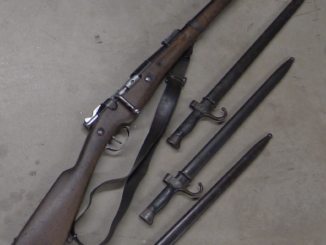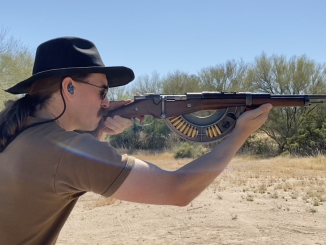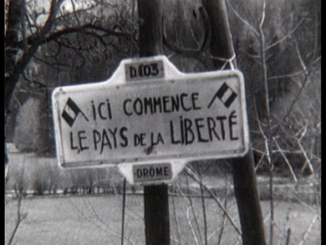The “Apache” was a combination knife, brass knuckles, and revolver made by several companies in Belgium and France, which became associated with a group of street thugs in Paris around the turn of the century. They were patented by a man named Louis Dolne and made in a variety of different styles, but all share the same basic mechanical features. One common misconception, I believe, is the idea that the folding blade was to be used in conjunction with the revolver. This makes basically no sense, but the blade would have had some utility if used with the brass knuckles.
This particular one is paired with a Belgian pinfire pepperbox, and available for sale at Rock Island on Friday the 20th.




I’ve seen pictures of these before (probably the same picture used multiple times), but I’d never realized how intricate and actually practical (to a degree, it does look a bit overly fiddly) a design it was, especially for a scuffle in a back alley.
It was actually the less common Delhaxhe revolver that was designed to allow all three “options” to be used at once;
http://images.delcampe.com/img_large/auction/000/069/010/873_001.jpg?v=1
On it, only the dagger blade folded.
(To find it on the Net, be careful of the spelling. Some sources misspell it “Delhaxie”.)
During WW2, SOE developed an experimental revolver for resistance use that was based on the Dolne design. It fired 9 x 19mm, which I believe makes it the first “purpose-built” revolver in that chambering in history. it’s illustrated on p. 515-516 of Handguns Of The World by Ezell.
It’s also noteworthy in that except for its cylinder, barrel, and the knife blade, most of the rest of it was composed of stampings, much like the American Guide Lamp Division (GM) FP-45 Liberator .45 ACP single-shot pistol.
cheers
eon
I wonder how the inventor intended this weapon to be used in practice? Do you first empty the revolver and if that doesn’t stop the assailant(s), try to continue with the knuckleduster? Since changing the “mode” takes some time, you’d better have some plan on how to use the thing…
Does anyone have any ballistic data on the 5mm pinfire cartridge? Judging from the images I have seen it must have made the .22 Short look like a Magnum.
From all indications, the thing could be used one of two ways;
1. Unfold “knucks” and dagger blade. Knucks form pistol grip, with dagger blade projecting forward like a mini-bayonet beneath the cylinder. This was the only way the revolver/pepperbox part could actually be fired. (The other way, the trigger remains folded up, and cannot be pulled.)
Single-shot pistols with folding or even spring-loaded “bayonets” were fairly common back then, as were “coaching” blunderbusses with similar setups (they survived well into the percussion period). While the foot-or-so-long bayonet on a “thunder gun” could certainly be used correctly, the mini-bayonets on pistols were more likely intended to be used like push-daggers, or simply to prevent the opponent grabbing the gun from your hand. (He tries it and gets sliced fingers for his trouble.)
2. Leave knucks folded, but unfold dagger blade. Hold gun wit hand around cylinder, fingers through knucks. Dagger blade now projects above or below hand, depending on which way you hold it. The result is basically a “trench knife” with a knuck-type handle and a smaller-than-average blade. The cylinder acts as a fist-load, and you don’t want to try to fire it in this position.
I could imagine a 1920s Paris tough pulling one like this (inherited from an ancestor, perhaps?) on an American, only to see said American out wit a Landers, Frary & Clark- made U.S. M1918 trench knife, which makes the Dolne look a bit anemic in comparison;
http://media.liveauctiongroup.net/i/14221/14395470_1.jpg
BTW, the British WW2 9mm version could be used exactly like the Dolne. I think it’s a pity they didn’t try to copy the Delhaxhe. Like the S&W Centennial, the Bodyguard, or for that matter the Colt National/Moore derringer, it could have been fired from within a coat pocket. A useful attribute for a covert operations weapon.
cheers
eon
Given a choice, I would rather have a Roth-Sauer pistol and a balisong (butterfly knife). The lack of a barrel makes the Apache revolver less than useless for shooting anyone who’s not trapped in a dark, narrow alley…
I imagine that you used what you thought appropriate for the situation at hand. Shooting and killing someone without good reason could have got you the guillotine, but bashing him with the brass knuckles was just another fight.
What this weapon did was to save you the weight and bulk involved in carrying three separate weapons. I must admit though that the knife seems to be a bit flimsy and I wouldn’t be inclined to rely on it.
Ian called it a “defensive weapon”, but it looks like the sort of thing which would appeal to street toughs and hooligans who went about looking for trouble. The pistol element would perhaps have been a last ditch measure if they got into more trouble than they had bargained for.
It would be most interesting to know what the average person’s understanding of the wounding potential of different gun’s or knife sizes was at that time? We have access to so much information nowadays but the average person and even some gun makers probably didn’t back then.
Another consideration is that perhaps in that era simply wounding an attacker was considered adequate to stop an attack. I recall an account of a 19th century lady (possibly George Custers wife?) telling a friend that her tiny deringer could be used to shoot a potential rapist in the leg.
I guess another factor is just that it enabled someone to save pocket space by carrying three weapons in one.
Having said all that I still think they are cool!
5mm pinfire, V0 – 150-170m/s, no data on bullet weight.
If we assume 2 g / 30 grains (which is reasonable I suppose), that would give E0 = 28 J / 21 ft-lbf (@ 170 m/s). That’s enough to pierce bare skin without problems, but probably would not kill an adult unless the bullet hits the eye or temple at close range. Heavy winter clothing would probably slow it down enough to stop it on the skin. (No, I won’t volunteer for a test with a pellet air rifle of similar muzzle energy 😉 )
The energy level of the 5mm pinfire is about that of the .22 BB cap, an average 18-grain bullet @ 780 for 24 FPE.
The CB cap is even closer, 30 grain @ 725 for 35 FPE (Eley-Kynoch factory loading).
This is slightly less energy than the 5.5mm Velo-Dog centerfire, which fired a 45-grain bullet at 650 FPS (198m/s)(Kynoch factory loading) or 750 FPS (229m/s)(Remington FL) for 42 and 55 FPE, respectively.
An even closer match would be the 5mm Bergmann auto round, either with or without extraction groove. It fired a 37 gr.lead or 34 gr. SP bullet at just under 600 FPS (183m/s) for ~ 30 FPE.
Barnes states that the Bergmann round was fairly useless for anything but indoor practice, having less than half the energy of the .25 ACP.
The 6.5mm Bergmann was better, with an 88-gr. bullet @ 690 FPS for 94 FPE. There was also a 65 gr. at the same velocity for 88 FPE. Neither one was up to the .32 ACP, but they were at least a bit better than the .25 ACP and way ahead of the 5mm.
Any or all of the above would outperform the 5mm Dolne. Frankly, a .22 Short puts it in the shade. (29 @ 1045 for 70 FPE in the standard-velocity FL.)
(All stats from Barnes, Cartridges Of The World, 6th ed.)
cheers
eon
1045fps is for smokeless .22 Short, BP was way less, IIRC about 600-650.
Hello Forgotten Weapons
I can give you some clarification.
The name “Apache” actually refer to the thugs of Paris and its surrounding (or any town, but it’s a term typical of Paris, a least today). They called themselves like that because Apaches and others American Natives (in France we say “indiens” (“indians”), but it’s maybe not a polite term in USA. Sorry by advance if I said an insulting word) are considered a free people that fight, and die, to keep its freedom and ride on horseback in the plains. A quite romantic view, indeed.
Those gangsters considered themselves as protesters and dissidents, so they adopted this name, “Apache”, to show they were marginals and rebels who lived free of the society rules.
They were NOT killers of innocent persons, bank robers, drugs or firearms dealers, and they had the reputation to not harm third party : they fought, yes, they were some kind of gangsters, yes, but they fought gang against gang. It’s not an absolute truth, obviously, but it’s a realistic portrait : people had fear of what we call “criminels” or “bandits”, but generally considered Apache as some kind of step in the youth of poor people that will be gone after a few years (obviously, things were a little bit more complicated than that portrait, because many had killed mens and stayed in the wrong way with the years).
The newspapers of the time greatly exagerated the portrait, by portraying them as something that resemble the gang in “Clockwork Orange”, but it was not the case. Yes, they were members of gangs and were on the wrong side of the law, but they were just young and poor violent idiots.
I don’t know if the revolver was named like that after years because it was used by Apaches or directly sold with this name as an attempt to catch the gangsters’ attention, but I would agree with the second proposal, because Appaches were known to use other weapons, notably the famous (in France, at least) “22” and not this little and complex “combo weapon”.
“22” was the nickname of the knives used by the Apaches, because its blade measured 22 cm (a little bit less than 9 inches). In fact, they used the knives they used, regardless of the mark, model or length of the blade, but great folding knives with 22 cm blade length were very popular (there is some kind of categories of knives in the French thug language and these categories are named by the average length of the blade in cm : 8, 12, 15, 22, 30, etc. It is absolutely not academic and this fashion has almost disappeared today).
There is even a locution in French which says “22, v’la les flics !”, which means “22, here come the cops !”. At the beginning, it was in fact “sortez vos 22, voilà les flics !”, which means “grab your 22, here come the cops”. Today, simply saying “22” means “let’s go [fast]”.
Those knives were generally jack-knives or robust folding hunting knives which were apprecited for their capacity to endure bad treatments like knife fights or for their psychological impact.
weapons of very small caliber with not really robust blade and complex mechanism were not appreciated by those gangsters, so the Appache knuckleduster revolver does not seems to be the real choice of the real Apache.
Today, “Apache” is still a word used (in Paris and its surrounding and only by the low to middle class old-France native peoples) to talk about some young peoples that feels not really comfortable in the society, that have sociability problems and are not really bad guys but are surely not good guys at all. The word don’t means “gangster” anymore, which equivalent in today’s French would be “criminel”, “racaille”, or “gangster” (directly borrowed from the english).
For exemple, I am considered an Apache. And I’m not a gangster. I don’t even have police reports ! I just take some distance with society’s rules and opinions, have very few friends, always wear a knife, a genuine Schott Perfecto and a pair of leather boots (three things that, in France, are considered evil), refuse to kneel in front of anybody (which cause me some problems to find a job. I solved the problem by working for myself), speak “argot” (Parisian dialect), am pugnacious and quite despising against the good neat and tidy right-thinking bourgeois.
Other kind of gangsters of that time (or a little bit later) were named “javanais” (“javanese”), “blousons noirs” (“black jackets”), etc.
Thanks for the background information – very interesting!
Have you ever thought about creating an ebook or guest authoring on other sites? I have a blog centered on the same subjects you discuss and would love to have you share some stories/information. I know my audience would appreciate your work. If you’re even remotely interested, feel free to send me an e mail.